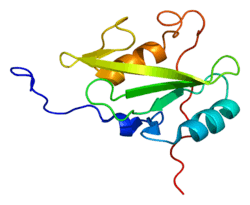VAV2
Guanine nucleotide exchange factor VAV2 is a protein that in humans is encoded by the VAV2 gene.[1][2]
VAV2 is the second member of the VAV oncogene family. Unlike VAV1, which is expressed exclusively in hematopoietic cells, VAV2 transcripts were found in most tissues.[2]
Interactions
VAV2 has been shown to interact with CD19[3] and Grb2.[4][5]
References
- ↑ Henske EP, Short MP, Jozwiak S, Bovey CM, Ramlakhan S, Haines JL, Kwiatkowski DJ (June 1995). "Identification of VAV2 on 9q34 and its exclusion as the tuberous sclerosis gene TSC1". Ann Hum Genet 59 (Pt 1): 25–37. doi:10.1111/j.1469-1809.1995.tb01603.x. PMID 7762982.
- ↑ 2.0 2.1 "Entrez Gene: VAV2 vav 2 oncogene".
- ↑ Doody, G M; Billadeau D D; Clayton E; Hutchings A; Berland R; McAdam S; Leibson P J; Turner M (November 2000). "Vav-2 controls NFAT-dependent transcription in B- but not T-lymphocytes". EMBO J. (ENGLAND) 19 (22): 6173–84. doi:10.1093/emboj/19.22.6173. ISSN 0261-4189. PMC 305817. PMID 11080163.
- ↑ Blagoev, Blagoy; Kratchmarova Irina; Ong Shao-En; Nielsen Mogens; Foster Leonard J; Mann Matthias (March 2003). "A proteomics strategy to elucidate functional protein-protein interactions applied to EGF signaling". Nat. Biotechnol. (United States) 21 (3): 315–8. doi:10.1038/nbt790. ISSN 1087-0156. PMID 12577067.
- ↑ Bourguignon, L Y; Zhu H; Zhou B; Diedrich F; Singleton P A; Hung M C (Dec 2001). "Hyaluronan promotes CD44v3-Vav2 interaction with Grb2-p185(HER2) and induces Rac1 and Ras signaling during ovarian tumor cell migration and growth". J. Biol. Chem. (United States) 276 (52): 48679–92. doi:10.1074/jbc.M106759200. ISSN 0021-9258. PMID 11606575.
Further reading
- Romero F, Fischer S (1997). "Structure and function of vav.". Cell. Signal. 8 (8): 545–53. doi:10.1016/S0898-6568(96)00118-0. PMID 9115846.
- Smit L, van der Horst G, Borst J (1996). "Sos, Vav, and C3G participate in B cell receptor-induced signaling pathways and differentially associate with Shc-Grb2, Crk, and Crk-L adaptors.". J. Biol. Chem. 271 (15): 8564–9. doi:10.1074/jbc.271.15.8564. PMID 8621483.
- Tamma SM, Chirmule N, Yagura H et al. (1997). "CD4 cross-linking (CD4XL) induces RAS activation and tumor necrosis factor-alpha secretion in CD4+ T cells.". Blood 90 (4): 1588–93. PMID 9269777.
- De Sepulveda P, Okkenhaug K, Rose JL et al. (1999). "Socs1 binds to multiple signalling proteins and suppresses steel factor-dependent proliferation.". EMBO J. 18 (4): 904–15. doi:10.1093/emboj/18.4.904. PMC 1171183. PMID 10022833.
- Pandey A, Podtelejnikov AV, Blagoev B et al. (2000). "Analysis of receptor signaling pathways by mass spectrometry: identification of vav-2 as a substrate of the epidermal and platelet-derived growth factor receptors.". Proc. Natl. Acad. Sci. U.S.A. 97 (1): 179–84. doi:10.1073/pnas.97.1.179. PMC 26636. PMID 10618391.
- Moores SL, Selfors LM, Fredericks J et al. (2000). "Vav family proteins couple to diverse cell surface receptors.". Mol. Cell. Biol. 20 (17): 6364–73. doi:10.1128/MCB.20.17.6364-6373.2000. PMC 86111. PMID 10938113.
- Liu BP, Burridge K (2000). "Vav2 activates Rac1, Cdc42, and RhoA downstream from growth factor receptors but not beta1 integrins.". Mol. Cell. Biol. 20 (19): 7160–9. doi:10.1128/MCB.20.19.7160-7169.2000. PMC 86269. PMID 10982832.
- Hartley JL, Temple GF, Brasch MA (2001). "DNA cloning using in vitro site-specific recombination.". Genome Res. 10 (11): 1788–95. doi:10.1101/gr.143000. PMC 310948. PMID 11076863.
- Doody GM, Billadeau DD, Clayton E et al. (2001). "Vav-2 controls NFAT-dependent transcription in B- but not T-lymphocytes.". EMBO J. 19 (22): 6173–84. doi:10.1093/emboj/19.22.6173. PMC 305817. PMID 11080163.
- Tartare-Deckert S, Monthouel MN, Charvet C et al. (2001). "Vav2 activates c-fos serum response element and CD69 expression but negatively regulates nuclear factor of activated T cells and interleukin-2 gene activation in T lymphocyte.". J. Biol. Chem. 276 (24): 20849–57. doi:10.1074/jbc.M010588200. PMID 11262396.
- Teckchandani AM, Feshchenko EA, Tsygankov AY (2001). "c-Cbl facilitates fibronectin matrix production by v-Abl-transformed NIH3T3 cells via activation of small GTPases.". Oncogene 20 (14): 1739–55. doi:10.1038/sj.onc.1204246. PMID 11313921.
- Jevremovic D, Billadeau DD, Schoon RA et al. (2001). "Regulation of NK cell-mediated cytotoxicity by the adaptor protein 3BP2.". J. Immunol. 166 (12): 7219–28. doi:10.4049/jimmunol.166.12.7219. PMID 11390470.
- Marignani PA, Carpenter CL (2001). "Vav2 is required for cell spreading.". J. Cell Biol. 154 (1): 177–86. doi:10.1083/jcb.200103134. PMC 2196856. PMID 11448999.
- Tamás P, Solti Z, Buday L (2001). "Membrane-targeting is critical for the phosphorylation of Vav2 by activated EGF receptor.". Cell. Signal. 13 (7): 475–81. doi:10.1016/S0898-6568(01)00172-3. PMID 11516622.
- Bourguignon LY, Zhu H, Zhou B et al. (2002). "Hyaluronan promotes CD44v3-Vav2 interaction with Grb2-p185(HER2) and induces Rac1 and Ras signaling during ovarian tumor cell migration and growth.". J. Biol. Chem. 276 (52): 48679–92. doi:10.1074/jbc.M106759200. PMID 11606575.
- Booden MA, Campbell SL, Der CJ (2002). "Critical but distinct roles for the pleckstrin homology and cysteine-rich domains as positive modulators of Vav2 signaling and transformation.". Mol. Cell. Biol. 22 (8): 2487–97. doi:10.1128/MCB.22.8.2487-2497.2002. PMC 133724. PMID 11909943.
- Tamás P, Solti Z, Bauer P et al. (2003). "Mechanism of epidermal growth factor regulation of Vav2, a guanine nucleotide exchange factor for Rac.". J. Biol. Chem. 278 (7): 5163–71. doi:10.1074/jbc.M207555200. PMID 12454019.
- Strausberg RL, Feingold EA, Grouse LH et al. (2003). "Generation and initial analysis of more than 15,000 full-length human and mouse cDNA sequences.". Proc. Natl. Acad. Sci. U.S.A. 99 (26): 16899–903. doi:10.1073/pnas.242603899. PMC 139241. PMID 12477932.
| |||||||||||




